
Tripping With the Maasai
Tears stream down my face. I fall behind the others and find a comfortable rock to sit and give myself some time and space. It is as if someone has slipped LSD in my water. I try to absorb the view, my surrounds, the sky, the earth, the contrasts, the extreme, painful, shocking beauty of this place on earth. No photograph, no words can express my emotions, but of course I cannot resist trying.

Imagine a desert. The air is dry and slightly dusty. A steady breeze moderates the heat. It is late afternoon and the dark sands radiate the day's heat back in your face. Stunted thornbush of myhrr and acacia dot the sand, with a few tough clumps of grass that have not yet been torn out by the surprising number of animals grazing this desiccated place. At every turn of the winding, rutted track you see more evidence that this is in fact a fertile land, dry as it may be: a herd of zebra, a giraffe poking his head out above a tree, as fascinated by me as I am by him, some wildebeest in the distance, a pair of impala, a thompson's gazelle – all big, native grazers, adapted to living here. They find water in the occasional spring and their food is the seasonal grasses and tough bushes that survive between the infrequent rains. There is a lake in the distance but from where you are the desert appears to run right up to the edge – there is no green verge, just desert then water. Something is not right.
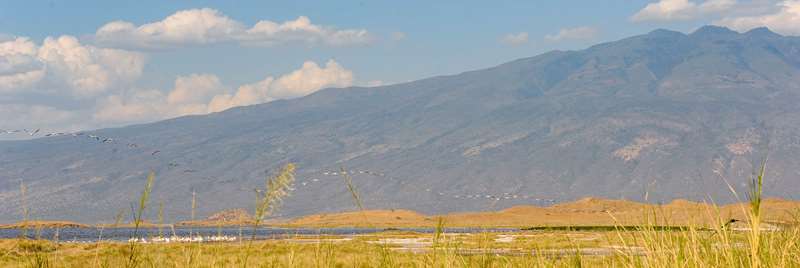
You look to the horizon. Across the lake in front of you is a small mountain, distant and unspectacular, but it emphasizes that we are in a big valley. Behind and to the left is a vertical escarpment several hundred metres high that runs for miles and disappears into the distance at the other end of the huge lake. It is riven at intervals by gorges that invite exploration – there must be springs, rivers, streams, waterfalls, surely? But there is very little green in this huge landscape, just dark sand, browns and yellows, and a huge blue sky over it all.
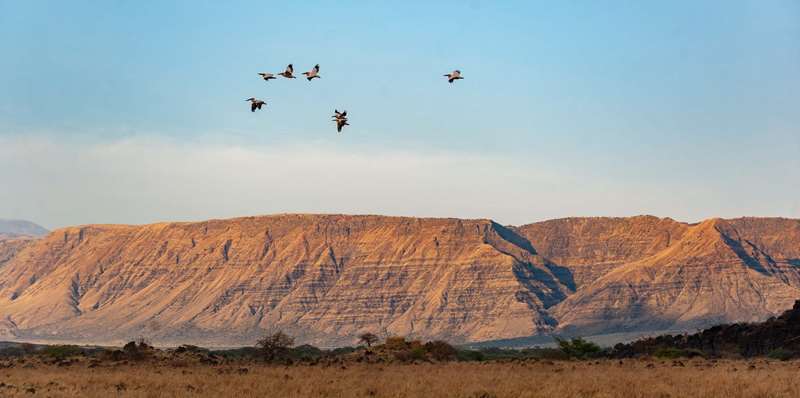
You walk across a small rocky plain. Nothing grows here. The ground is solid rock with strange marks, as you look closer you see that the marks are cloven hoof prints: cattle? antelope? And then you see something that takes your breath away, a small human footprint embedded in the solid rock. As you go further there are many more unmistakable footprints, made by people who passed this way tens of thousands of years ago, maybe hunting those cloven-footed animals across what was then a muddy swamp. The dark sands cover the rock again and the mysterious footprints disappear beneath it.
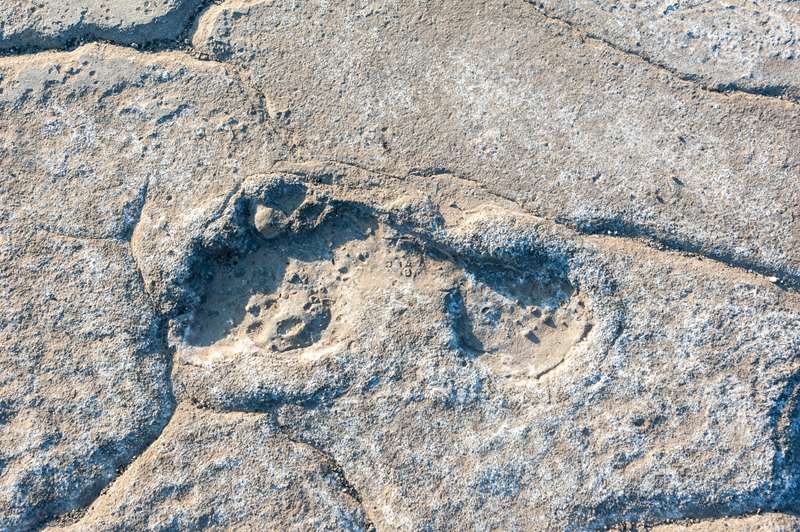
The land rises as we continue walking towards the lake, with larger rocks, a surprising amount of dry grass, and the occasional lizard scurrying out of the way. A snake eagle perches at the top of a small tree, watching and waiting. Not the most elegant of birds, it has the proportions of a chicken and doesn't look like it could fly. Then it looks at you. This is no chicken. The forward-facing yellow eyes bore into you leaving no doubt that this is a predator. Now it spreads its wings, takes to the air, and transforms into the most majestic of winged beasts.
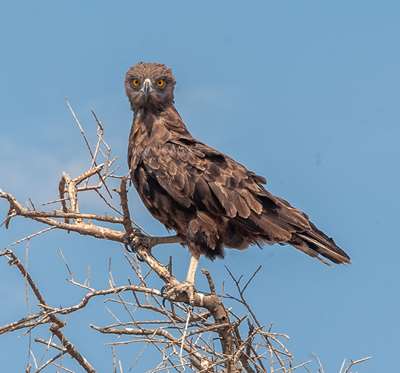
As you crest the ridge the most amazing view unfolds: the brown dry stoney desert at your feet drops away to an intense green swath of swamp that connects the base of the ridge with the lake. A freshwater spring emerges from the base of the hill directly below, drops into a beautiful rocky pool and rushes away in a stream that meanders thru the swamp. The contrast is profound, the late afternoon colors so vibrant you drop onto that rock to take it all in. That dry expanse of desert suddenly acquires new yellows and brown merely from its juxtaposition with the verdant green surrounding the spring and the intense blue of the sky overhead.
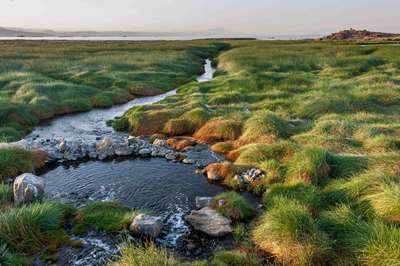
There is one more feature of this landscape that you have not yet acknowledged. It is so majestic, so huge and dominating, so perfect in its symmetry and color, and so overwhelming in the setting sun that you don't know where to begin. The Maasai call it The Mountain of God, Ol Doinyo Lengai – a perfectly formed volcano that reaches from the valley floor and soars above the lake and even the escarpment. The late afternoon sun etches the lines of lava and the eroded surface. At the summit is white. It looks like snow but cannot possibly be – we are just a few hundred kilometres from the equator. Below the summit the pastel colors are all browns and yellows. The mountain is stunningly beautiful, and it dominates everything.

This is the eastern branch of the Great Rift Valley of Africa – a tear in the crust of the planet that stretches 6,000 kilometres from the Beqaa Valley in Lebanon to Mozambique. The East African Rift, where you stand, will one day be sea floor as eastern Somalia, Kenya and part of Tanzania are torn from the African continent, forming a new land mass – the Somalian Plate. This is a place of gigantic forces; forces way beyond those man wields, forces that act over millions of years and make nuclear weapons look puny.
The darkness of the sand is a clue to the nature of this place. Ol Doinyo Lengai last erupted in 1960 and is still an active volcano. Every other volcano on earth spews lava made of silica; this is the only one that spews lava of carbonatite, a mineral comprised of carbon and sodium instead of the silicon of every other volcano. It is black as it comes out of the vent, turns white when it meets the atmosphere and cools, accounting for the white snow-like patches at the summit, and gradually breaks down into the dark alkaline sand which is everywhere. The springs and rivers flowing through the land dissolve sodium carbonate out of the sand and rock and carry it to the lake.
Lake Natron is fed by many streams and springs from the mountain and the escarpment, all carrying dissolved sodium carbonate to the lake. But the lake has no outlet. The lake evaporates and accumulates the salts, becoming extremely alkaline in the process, with a pH of 12. It is similar to laundry detergent in both composition and strength. Your skin goes soft and slippery when you swim in it. Its alkalinity prevents the growth of many plants, accounting for the bare desert right up to the lake edge. No reeds or grasses grow in the lake itself, but where a fresh stream flows a wonderland of green erupts accounting for the amazing swamp before us.
This is also the place where Homo Sapiens evolved. The home of man. Unless you are African, the footprints you saw are too young to have come from one of your ancestors – they are only a few tens of thousands of years old. However, it is almost certain that no matter what race you are or what color your skin is, one of your ancestors lived in this region 100,000 years ago.
As I sit on my rock and the tears roll down my face I realize just how important this whole journey is. I am slowly learning some of the philosophy of Africa: this is just one more way to see the deep interconnectedness of everything. For a moment I glipse how we all relate to each other, to all life, and to the landscape. There is a Bantu word that expresses this – ubuntu:
For us, it is based on the African concept of ubuntu – the essence of being human – that a person is a person only through other persons, that my humanity is caught up in yours. I am fully me only if you are all you can be.
— Desmond Tutu, 2008
Finally, I get up, dry my face, walk down the hill to the others and accept a glass of wine from Wilson, our Maasai guide, who smiles broadly.